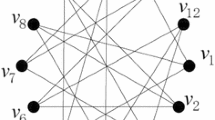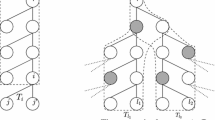Abstract
We initiate the study of relaxed \(L(2,1)\)-labelings of graphs. Suppose \(G\) is a graph. Let \(u\) be a vertex of \(G\). A vertex \(v\) is called an \(i\)-neighbor of \(u\) if \(d_G(u,v)=i\). A \(1\)-neighbor of \(u\) is simply called a neighbor of \(u\). Let \(s\) and \(t\) be two nonnegative integers. Suppose \(f\) is an assignment of nonnegative integers to the vertices of \(G\). If the following three conditions are satisfied, then \(f\) is called an \((s,t)\)-relaxed \(L(2,1)\)-labeling of \(G\): (1) for any two adjacent vertices \(u\) and \(v\) of \(G, f(u)\not =f(v)\); (2) for any vertex \(u\) of \(G\), there are at most \(s\) neighbors of \(u\) receiving labels from \(\{f(u)-1,f(u)+1\}\); (3) for any vertex \(u\) of \(G\), the number of \(2\)-neighbors of \(u\) assigned the label \(f(u)\) is at most \(t\). The minimum span of \((s,t)\)-relaxed \(L(2,1)\)-labelings of \(G\) is called the \((s,t)\)-relaxed \(L(2,1)\)-labeling number of \(G\), denoted by \(\lambda ^{s,t}_{2,1}(G)\). It is clear that \(\lambda ^{0,0}_{2,1}(G)\) is the so called \(L(2,1)\)-labeling number of \(G\). \(\lambda ^{1,0}_{2,1}(G)\) is simply written as \(\widetilde{\lambda }(G)\). This paper discusses basic properties of \((s,t)\)-relaxed \(L(2,1)\)-labeling numbers of graphs. For any two nonnegative integers \(s\) and \(t\), the exact values of \((s,t)\)-relaxed \(L(2,1)\)-labeling numbers of paths, cycles and complete graphs are determined. Tight upper and lower bounds for \((s,t)\)-relaxed \(L(2,1)\)-labeling numbers of complete multipartite graphs and trees are given. The upper bounds for \((s,1)\)-relaxed \(L(2,1)\)-labeling number of general graphs are also investigated. We introduce a new graph parameter called the breaking path covering number of a graph. A breaking path \(P\) is a vertex sequence \(v_1,v_2,\ldots ,v_k\) in which each \(v_i\) is adjacent to at least one vertex of \(v_{i-1}\) and \(v_{i+1}\) for \(i=2,3,\ldots ,k-1\). A breaking path covering of \(G\) is a set of disjoint such vertex sequences that cover all vertices of \(G\). The breaking path covering number of \(G\), denoted by \(bpc(G)\), is the minimum number of breaking paths in a breaking path covering of \(G\). In this paper, it is proved that \(\widetilde{\lambda }(G)= n+bpc(G^{c})-2\) if \(bpc(G^{c})\ge 2\) and \(\widetilde{\lambda }(G)\le n-1\) if and only if \(bpc(G^{c})=1\). The breaking path covering number of a graph is proved to be computable in polynomial time. Thus, if a graph \(G\) is of diameter two, then \(\widetilde{\lambda }(G)\) can be determined in polynomial time. Several conjectures and problems on relaxed \(L(2,1)\)-labelings are also proposed.



Similar content being viewed by others
References
Araujo J, Bermond J-C, Giroire F, Havet F, Mazauric D, Modrzejewski R (2012) Weighted improper colouring. J Discret Algorithms 16:53–66
Bodlaender HL, Kloks T, Tan RB, van Leeuwen J (2004) Approximations for \(\lambda \)-colorings of graphs. Comput J 47:193–204
Bondy JA, Murty USR (1976) Graph theory with applications. North Holland, New York
Calamoneri T (2011) The L(h, k)-labeling problem: an updated survey and annotated bibliography. Comput J 54(8):1344–1371
Chang GJ, Kuo D (1996) The L(2,1)-labeling problem on graphs. SIAM J Discret Math 9:309–316
Chen Q, Lin W (2012) \(L(j, k)\)-labelings and \(L(j, k)\)-edge-labelings of graphs. Ars Comb 106:161–172
Dai B, Lin W (2013a) On \((s, t)\)-relaxed \(L(2,1)\)-labelings of the square lattice. Inf Process Lett 113(19–21):704–709
Dai B, Lin W (2013b) On \((s, t)\)-relaxed \(L(2,1)\)-labelings of the hexagonal lattice, accepted by Ars Combin.
Duan Z, Lv P, Miao L, Miao Z, Wang C (2011) The \(\Delta ^2\)-conjecture for \(L(2,1)\)-labelings is true for total graphs. Appl Math Lett 24:1491–1494
Eggemann N, Havet F, Noble SD (2010) \(k\)-\(L(2, 1)\)- labelling for planar graphs is NP-complete for \(k\ge 4\). Discret Appl Math 158:1777–1788
Georges JP, Mauro DW, Whittlesey MA (1994) Relating path coverings to vertex labellings with a condition at distance Two. Discret Math 135:103–111
Griggs JR, Yeh RK (1992) Labeling graphs with a condition at distance \(2\). SIAM J Discret Math 5:586–595
Griggs JR, Jin XT (2007) Recent progress in mathematics and engineering on optimal graph labellings with distance conditions. J Comb Optim 14(2–3):249–257
Fiala J, Kloks T, Kratochvl J (2001) Fixed-parameter complexity of \(\lambda \)-labelings. Discret Appl Math 113(1):59–72
Havet F, Reed B, Sereni J-S (2012) Griggs and Yehs conjecture and L(p,1)-labelings. SIAM J Discret Math 26(1):145–168
Hoffman AJ, Singleton RR (1960) On Moore graphs with diameters 2 and 3. IBM J Res Develop 4:497–504
Hopcroft JE, Karp RM (1973) An \(n^{5/2}\) algorithm for maximum matchings in bipartite graphs. SIAM J Comput 2(4):225–231
Hasunuma T, Ishii T, Ono H, Uno Y (2009) An \(O(n^{1.75})\) algorithm for L(2, 1)-labeling of trees. Theor Comp Sci 410:3702–3710
Hasunuma T, Ishii T, Ono H, Uno Y (2009) A linear time algorithm for \(L(2,1)\)-labeling of trees. In: Proceedings 17th Annual European Symposium on Algorithms (ESA09), Copenhagen, Denmark, Lecture Notes in Computer Science 5757:35–46 Springer, Berlin.
Klavžar S, Špacapan S (2006) The \(\Delta ^2\)-conjecture for \(L(2,1)\)-labelings is true for directed and strong products of graphs. IEEE Trans Circuits Syst II 53:274–277
Lin W, Dai B (2013) On \((s, t)\)-relaxed \(L(2,1)\)-labelings of the triangular lattice, to appear in J Comb Optim. doi:10.1007/s10878-013-9615-y
Lin W, Lam PCB (2009) Star matching and distance two labelling. Taiwanese J Math 13(1):211–224
Liu DD-F (2001) Hamiltonicity and circular distance two labellings. Discret Math 232:163–169
Yeh RK (2006) A survey on labeling graphs with a condition at distance two. Discret Math 306:1217–1231
Acknowledgments
Project 10971025 supported by NSFC
Author information
Authors and Affiliations
Corresponding author
Appendix: The proof of Theorem 6.2
Appendix: The proof of Theorem 6.2
We use the following four lemmas to prove Theorem 6.2.
Lemma 9.1
Let \(G\) be a graph on \(n\) vertices. Then \(\widetilde{\lambda }(G)\le n+bpc(G)-2\).
Proof
Let \(q=bpc(G)\). Suppose \(\{P_1,P_2,\ldots ,P_q\}\) is a breaking path covering of \(G\) with \(P_i=v_{i_1},v_{i_2},\ldots ,v_{i_{p_i}}\) for \(i=1,2,\ldots ,q\). For each \(i\in \{1,2,\ldots ,q\}\) and \(j\in \{1,2,\ldots ,p_i\}\), let
Then it is straightforward to check that \(f\) is a relaxed \(L(2,1)\)-labeling of \(G\) with span \(n+bpc(G)-2\). Thus the lemma follows. \(\square \)
Let \(f\) be a relaxed \(L(2,1)\)-labeling of \(G\) with span \(p\). For \(j=0,1,\ldots ,p\), denote by \(F_j\) the set of vertices with label \(j\) and \(f_j\) the order of \(F_j\). If \(f_j=0\), then \(j\) is called a hole of \(f\). In a relaxed \(L(2,1)\)-labeling with minimum span, it is clear that \(0\) and \(p\) can not be holes. If \(f_j\ge 2\), then \(j\) is called a multiplicity of \(f\). Suppose \(g\) is a hole of \(f\). If \(f_{g-1}=f_{g+1}=1\) and the two vertices with labels \(g-1\) and \(g+1\) respectively are adjacent, then \(g\) is called a gap of \(f\). The set of multiplicities of \(f\) is denoted by \(M(f)\) and the set of gaps of \(f\) is denoted by \(G(f)\).
A relaxed \(L(2,1)\)-labeling \(f\) of \(G\) is called optimal if \(span(f)=\widetilde{\lambda }(G)\). We say that an optimal relaxed \(L(2,1)\)-labeling \(f\) of \(G\) is minimum if \(f\) has the minimum number of holes over all optimal relaxed \(L(2,1)\)-labelings.
Lemma 9.2
Let \(f\) be a minimum relaxed \(L(2,1)\)-labeling of \(G\). If \(h\) is a hole of \(f\) then \(f_{h-1}=f_{h+1}>0\) and \(G[F_{h-1}\cup F_{h+1}]\) is \(1\)-regular. In particular, if \(f_{h-1}=f_{h+1}=1\), then \(h\) is a gap.
Proof
Since \(f\) is an optimal relaxed \(L(2,1)\)-labeling of \(G\), it is clear that \(f\) has no consecutive holes. It follows that if \(h\) is a hole of \(f\), then \(f_{h-1}\) and \(f_{h+1}\) are positive.
If there is one vertex, say \(w\), in \(F_{h-1}\) (or \(F_{h+1}\)) that is not adjacent to any vertex in \(F_{h+1}\) (or \(F_{h-1}\)), then, by relabeling the vertex \(w\) with the label \(h\), we obtain a new optimal relaxed \(L(2,1)\)-labeling with fewer holes than \(f\), contradicting the choice of \(f\). Since vertices with the same label are at distance at least \(3\), each vertex in \(F_{h-1}\) (respectively, \(F_{h+1}\)) is adjacent to at most one vertex in \(F_{h+1}\) (respectively, \(F_{h-1}\)). It follows that each vertex in \(F_{h-1}\) (respectively, \(F_{h+1}\)) is adjacent to exact one vertex in \(F_{h+1}\) (respectively, \(F_{h-1}\)). This implies that \(f_{h-1}=f_{h+1}\) and \(G[F_{h-1}\cup F_{h+1}]\) is \(1\)-regular. Therefore, if \(f_{h-1}=f_{h+1}=1\), then \(h\) is a gap. \(\square \)
Lemma 9.3
At least one of \(G(f)\) and \(M(f)\) is empty.
Proof
Suppose that \(G(f)\) and \(M(f)\) are all nonempty. Let \(g\) and \(m\) be a gap and a multiplicity of \(f\) respectively. Suppose \(m<g\) and between \(m\) and \(g\) there is no gaps and multiplicities. Then \(m<g-1\) and \(f_j=1\) for \(m<j<g\). Let \(v_{j}\) be the only vertex in \(F_j\) for \(j=m+1,m+2,\ldots ,g-1,g+1\)
We claim that \(f_m=2\). Let \(w\) be a vertex in \(F_m\). If \(w\) is not adjacent to both \(v_{g-1}\) and \(v_{g+1}\), then by relabeling the vertex \(w\) with the label \(g\) we obtain a new optimal relaxed \(L(2,1)\)-labeling with fewer number of holes than \(f\), contradicting the choice of \(f\). Thus each vertex \(w\) in \(F_m\) is adjacent to at least one vertex of \(v_{g-1}\) and \(v_{g+1}\), implying \(f_m=2\).
Let \(F_m=\{w_1,w_2\}\). Then \(w_1v_{g-1}\in E(G)\) and \(w_2v_{g+1} \in E(G)\), or \(w_2v_{g-1}\in E(G)\) and \(w_1v_{g+1} \in E(G)\). With no loss of generality, suppose \(w_1v_{g-1}\in E(G)\) and \(w_2v_{g+1} \in E(G)\). Then \(w_1\) is not adjacent to \(v_{g+1}\) and \(w_2\) is not adjacent to \(v_{g-1}\). Define
Since \(f\) is a relaxed \(L(2,1)\)-labeling of \(G\), no vertex \(v_j\in \{v_{m+2},\ldots ,v_{g-2}\}\) is adjacent to both \(v_{j-1}\) and \(v_{j+1}\). Note that \(w_1\) is not adjacent to \(v_{g+1}\) and \(w_2\) is not adjacent to \(v_{g-1}\), it is obvious that \(f'\) is an optimal relaxed \(L(2,1)\)-labeling with fewer number of holes than \(f\). This contradicts the choice of \(f\). Thus at least one of \(G(f)\) and \(M(f)\) is empty. \(\square \)
Lemma 9.4
Let \(G\) be a graph on \(n\) vertices. Then \(\widetilde{\lambda }(G)\le n-1\) if and only if \(bpc(G^c)=1\).
Proof
By Lemma 9.1, if \(bpc(G^c)=1\), then \(\widetilde{\lambda }(G)\le n-1\).
Now suppose \(\widetilde{\lambda }(G)\le n-1\). It suffices to find a Hamiltonian breaking path of \(G^c\). Let \(f\) be a minimum relaxed \(L(2,1)\)-labeling of \(G\). We claim that \(f\) has no gaps. If \(f\) has no holes, then of course \(f\) has no gaps. If \(f\) has at least one hole, then since there are \(n\) vertices, by the pigeon-hole principle, \(f\) has at least one multiplicity. By Lemma 9.3, \(f\) has no gaps.
Let the span of \(f\) be \(p\) (\(\le n-1\)). Note that, for \(j=0,1,\ldots ,p\), any two vertices in \(F_j\) are at distance at least \(3\). Thus \(F_j\) is an independent set in \(G\). Due to the distance two condition, the subgraph induced by \(F_j\cup F_{j+1}\) has maximum degree at most \(1\) for \(j=0,1,\ldots ,p-1\). For \(j=0,1,\ldots ,p-2\), if \(F_j\) is nonempty but \(F_{j+1}\) is empty, then \(j+1\) is a hole, by Lemma 9.2, the subgraph induced by \(F_j\cup F_{j+2}\) is \(1\)-regular. Let the vertices in \(F_j\) be \(v_{j1},v_{j2},\ldots ,v_{j{f_j}}\) for \(j=0,1,\ldots ,p\). Then
is a Hamiltonian breaking path of \(G^c\) since \(f\) is a relaxed \(L(2,1)\)-labeling of \(G\) and so each vertex in \(F_j\) is adjacent to at most one vertex in \(F_{j-1}\cup F_{j+1}\) for \(j=1,2,\ldots ,p-1\). Thus \(bpc(G^c)=1\). \(\square \)
We are now ready to prove Theorem 6.2.
Proof of Theorem 6.2
By Lemma 9.4, to prove Theorem 6.2, it is sufficient to show that \(\widetilde{\lambda }(G)=n+k-2\) if and only if \(bpc(G^c)=k\) for \(k\ge 2\). We prove this by mathematical induction.
Suppose \(bpc(G^c)=2\). Then \(\widetilde{\lambda }(G)\le n\) by Lemma 9.1, and \(\widetilde{\lambda }(G)\ge n\) by Lemma 9.4. Thus \(bpc(G^c)=2\) implies \(\widetilde{\lambda }(G)=n\). If \(\widetilde{\lambda }(G)=n\), then \(bpc(G^c)\ge 2\) by Lemma 9.4. Let \(G_1\) be the graph obtained from \(G\) by adding an isolated vertex \(z\). Then \(\widetilde{\lambda }(G_1)=\widetilde{\lambda }(G)=n=|V(G_1)|-1\). It follows from Lemma 9.4 that \(bpc(G_{1}^{c})=1\). Let \(P\) be a Hamiltonian breaking path of \(G_{1}^{c}\). By deleting \(z\) from \(P, P\) is divided into two breaking paths in \(G^c\) covering all vertices, implying that \(bpc(G^c)\le 2\). Therefore, \(\widetilde{\lambda }(G)=n\) implies \(bpc(G^{c})=2\).
Suppose \(\widetilde{\lambda }(G)=n+i-2\) if and only if \(2\le bpc(G^c)=i <k\). If \(bpc(G^c)=k\), then, by Lemma 9.1 and the induction hypothesis, \(\widetilde{\lambda }(G)= n+k-2\). If \(\widetilde{\lambda }(G)= n+k-2\), then by Lemma 9.1, \(bpc(G^c)\ge k\). Let \(G_1\) be the graph obtained from \(G\) by adding an isolated vertex \(z\). Then \(\widetilde{\lambda }(G_1)=\widetilde{\lambda }(G)=n+k-2=|V(G_1)|+(k-1)-2\). It follows from the induction hypothesis that \(bpc(G_1^c)=k-1\). Let \(\mathcal {P}\) be a breaking path covering of \(G_1^c\) of order \(k-1\). By deleting \(z\) from the breaking path in \(\mathcal {P}\) containing \(z\), we obtain a breaking path covering of \(G^c\) of order at most \(k\), implying \(bpc(G^c)\le k\). Thus \(bpc(G^c)= k\). The induction step is completed. \(\square \)
Rights and permissions
About this article
Cite this article
Lin, W. On \((s,t)\)-relaxed \(L(2,1)\)-labeling of graphs. J Comb Optim 31, 405–426 (2016). https://doi.org/10.1007/s10878-014-9746-9
Published:
Issue Date:
DOI: https://doi.org/10.1007/s10878-014-9746-9




